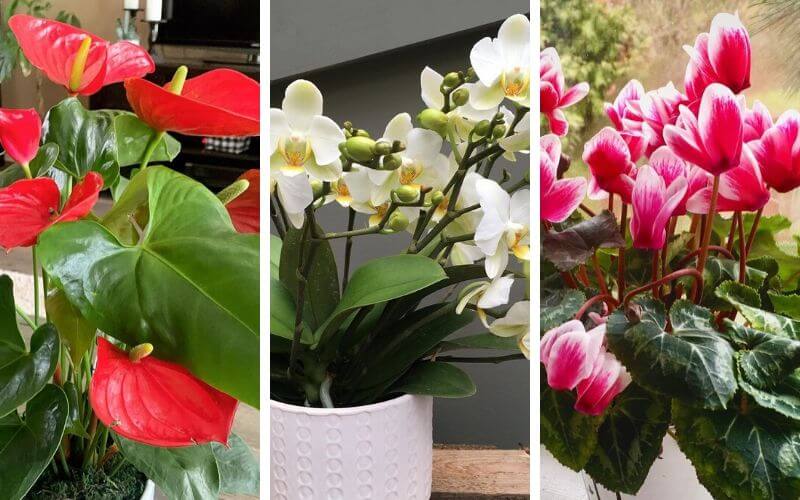
Most plants need plenty of light to blossom, but, especially indoors, at home or in your office, all you can offer is very often a dark corner… So, how can you have flowers even in low light?
Nature is very resourceful, thankfully, and there are quite a few stunning low light flowering plants you can grow indoors.
There is no flowering houseplant you can grow in complete darkness; however, there are some that will blossom even in half shade and poorly lit conditions; these are often tropical plants that grow under the canopies of forests, like Phalaenopsis, Anthurium, bromeliads and Brazilian fireworks.
We shall see 12 great flowering plants that you can grow in your home or office even if you can’t offer them good light exposure and we’ll also look at some tips on how to grow them successfully.
12 Low Light Flowering Houseplants That Need Little Light
Here’s a list of 12 low-light flowering Houseplants that will suit even dimply lit indoor spaces:
Bromeliads

The light you get in many room is dim and often like the dappled shade you get in tropical forests.
This is why bromeliads make excellent houseplants; they are succulents from the forested regions Central and South America.
The 75 species of bromeliads have become more and more popular as indoor plants because not only do they have flowers, but they also grow perfectly well in dimly lit places.
But there is more, what many people often mistake for bromeliad flowers, are brightly colored modified leaves called brats; these can be white, yellow, pink, orange, red or purple, and they have very original and unusual shapes, like a beaver tail, or star shaped rosettes etc.
The advantage of brats is that they are permanent on the plant, unlike flowers.
They are very unusual succulents because not only do they like shady places, but they also want frequent watering.
Tips For Growing Bromeliads
Phalaenopsis

When a room needs peaceful light there is no better plant than a flowering orchid for it.
The world’s favorite orchid, most likely, Phalaenopsis, is fast becoming a household name as “the orchid every one can grow”. And we can add, even if you don’t have plenty of light.
Yes, the “butterfly orchid”, in fact, is well suited for dimly lit places, and with its long lasting blooms, it’s beautiful waxy leaves and elegant presence, it has now made its way into all retailers, including supermarkets.
With almost 60 different species to offer, now even affordable when it comes to the price, you can now enjoy its beautiful presence even on that shelf far away from your window, among your favorite books and heirlooms.
Tips For Growing Phalaenopsis
Christmas Cactus

This houseplant’s flowers resemble those bells that light up at Christmas, in living rooms, offices and shops.
Christmas cactus or Schlumbergera is one of the most popular indoor succulents, thanks to its lush, plentiful, original and long lasting blooms. It will like positions away from direct light (and direct heat), and it does not equine too much care.Unfortunately, people tend to forget about their and I often find them in poor conditions.
Tips For Growing Christmas Cactus
Gloxinia

Meet a beautiful flowering houseplant from South America that can live where light is scarce (but not missing altogether…): Gloxinia.
With very richly colored flowers and decorative, at times heart shaped leaves, this small plant can grow well even in a tiny and half-shade corner that needs a touch of beauty.
The flowers are large compared to the size of the plant, and they can add a rainbow of colors to any room or indoor space; in fact, they can range from white to dark purple, via orange, pink and red. Some are even dichromatic, with petals of two different colors.
Tips For Growing Gloxinia
African Violet

African violets can bring a vibrant colors and playful shapes to dimly lit corners of your home.
Small and easy to grow, Saintpaulia lighten up even the dullest place in your living room with the joy and vitality of the African Continent where they come from.
These plants can blossom where light is low, and their beautiful, soft and fleshy leaves will always add a touch of sensuousness to the place you choose for them.
Tips For Growing African Violets
Clivia
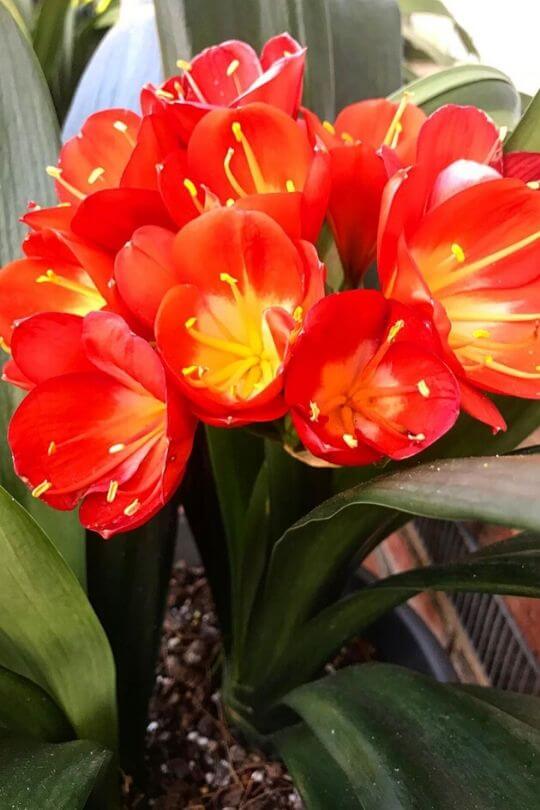
Clivia is a flowering houseplant that can add a touch of warm light to your room: with beautiful, long leaves and inflorescence with tubular flowers that range from light yellow to red, Clivia has become a popular houseplant, and it adapts very well to low light conditions.
This genus of flowering plants comes from the forests of South Africa and Swaziland, where you can find it in the undergrowth, where light is scarce.
Tips For Growing Clivia
Brazilian Fireworks

If you want spots of white brightness in a room that needs light, then lesser known houseplant, Porphyrocoma pohliana, or Brazilian fireworks, is a fairly large plant with dichromatic pointed leaves, dark green with almost white veins, and beautiful red and purple blooms.
Actually, the flowers are on the violet side and they remind those of sage in shape, but they are accompanied by red-purplish brats that add to their beauty.
This evergreen plant grows well even in mostly shaded places, which makes it ideal to liven up those dark corners in offices and living spaces we all have.
What is more, this is an ever bloomer; it will blossom again and again, from spring to winter!
Tips For Growing Brazilian Fireworks
Anthurium

Anthurium can light up any room with its shiny red spathe, its large waxy leaves and its great architectural presence.
This Central and South American exotic plant is also available with white or pink spathes if you prefer.
The spathe is that modified leaf that surrounds that thin spike of tiny flowers botanists call spadix, the actual reproductive organ of the plant.
Each bloom can last up to three months, so, you are guaranteed a splash of color for a very long time if you choose this houseplant.
Tips For Growing Anthurium
Peace Lily
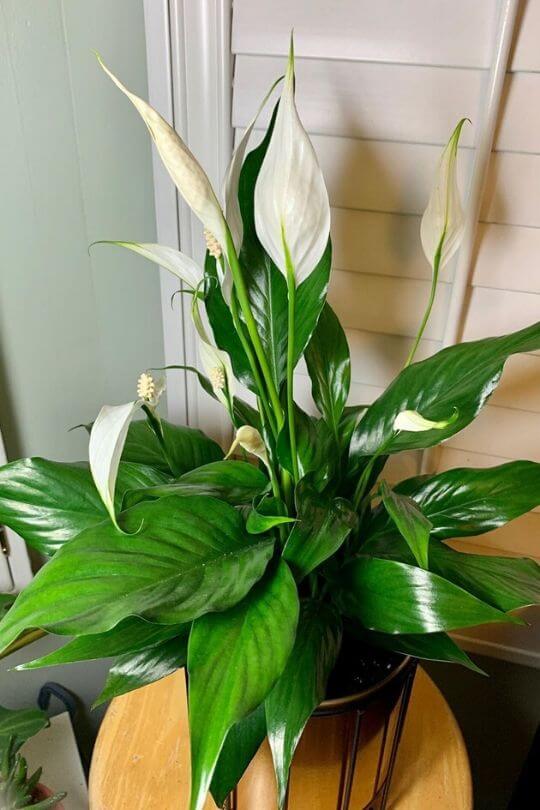
Even if your room is dimly lit, peace lily as a houseplant will bring a touch of beautiful calm with its leaves and white spathes, which look like big, solitary petals, and they don’t need much light to do all this.
Related to anthurium, they also look very much like them, a bit like a white and thin version of their cousins.
As a houseplant, Spathiphyllum is very popular because it requires little care and it can fill any, even dimly lit, indoor space with its candid grace, as it does in the forests of Venezuela and Colombia where it comes from.
The contrast of the dark, deep green leaves and white spathes adds to the architectural beauty of this houseplant.
Tips For Growing Peace Lily
Cyclamen
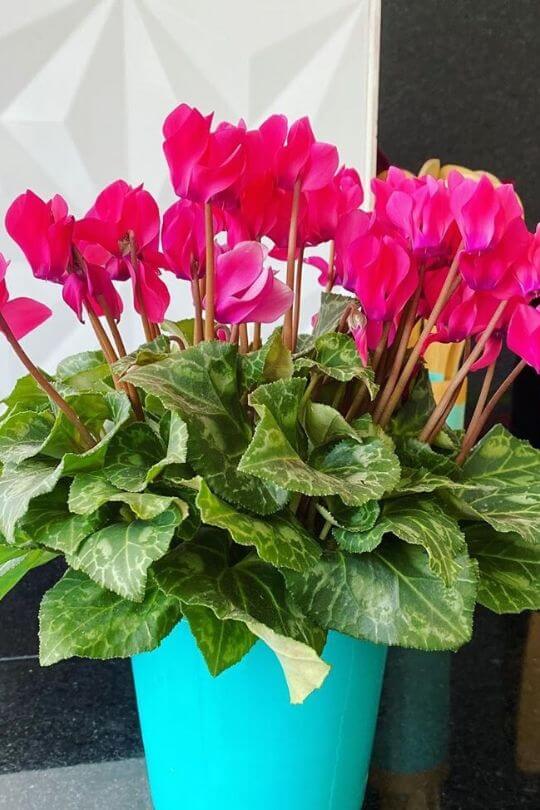
Cyclamens are great winter bloomers, when light is low, and this when they are grown as houseplants too; they like shady places and their original flowers have fascinated gardeners and amateurs for millennia.
In temperate zones, the small native species can be found in woods, and they are one of the few flowering plants that can grow under pine trees.
Most indoor varieties, however, are cultivars derived from species like Cyclamen persicum, which hails from the Middle East.
These a plants that need a bit of light, but not too much; just an hour of good light a day and the rest in part shade will suffice.
Ideal for small spaces, like office desks and bookshelves, cyclamens are sometimes delicate though, so, they need a bit of care.
Tips For Growing Cyclamens
Amaryllis
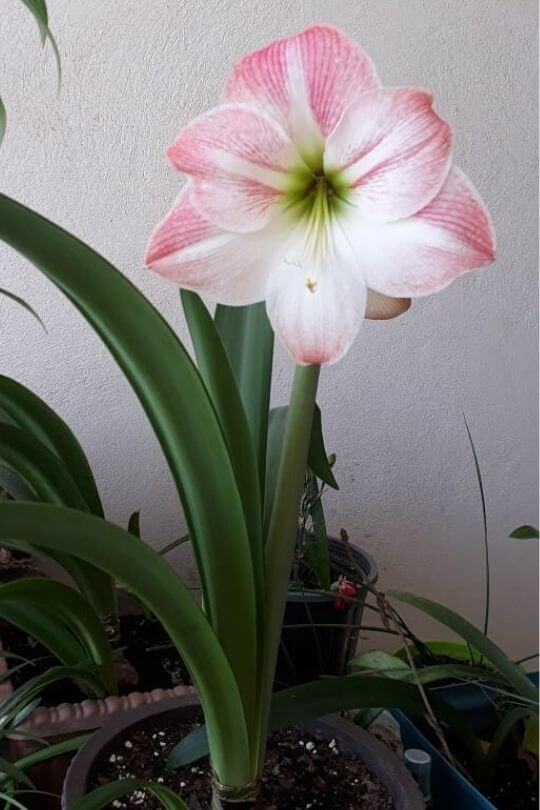
You can’t miss an amaryllis in a room… With its huge star shaped flowers, long and thin leaves, bright colors and almost imposing presence, this flower is an eye catcher like few. It is a winter flowering houseplant, so, it does not require much light.
This stunning flower has become popular when bulbs started traveling by mail, and every gardener will remember that time… I still recall when I first saw what appeared like a “flower from out of space” in a famous Dutch bulb catalogue, fell in love with it an bought it.
I thought it would be a con, instead, the massive bulb arrived and in a few weeks I had a huge, red flower in my living room.
Tips For Growing Amaryllis
Wax Plant

Original and lesser known wax plant will give you star shaped white flowers in clusters and large and shiny leaves to bring light even where sunlight is very scarce in your indoor spaces.
Also known as porcelain flower, Hoya carnosa is an exotic plant from Australia and Eastern Asia whose flowers are not just beautiful; they also have a wonderful scent to perfume your room.
Tips For Growing Wax Plant
Brighten Up Dark Indoor Corners with Flowering Houseplants
Maybe not many flowering plants are suitable for both dark and indoor spaces, true. In fact the choice is not huge.
Still, there are enough, with different shapes and colors, to fill in the odd dull and dimly lit spot in your home or office.
Whether you choose a Phalaenopsis or a peace lily, an African violets or a Christmas cactus, your room will always look better and even brighter with one of the beautiful flowering Houseplants we have met in this article.

Written By
Amber Noyes
Amber Noyes was born and raised in a suburban California town, San Mateo. She holds a master’s degree in horticulture from the University of California as well as a BS in Biology from the University of San Francisco. With experience working on an organic farm, water conservation research, farmers’ markets, and plant nursery, she understands what makes plants thrive and how we can better understand the connection between microclimate and plant health. When she’s not on the land, Amber loves informing people of new ideas/things related to gardening, especially organic gardening, houseplants, and growing plants in a small space.

When I originally commented I clicked the “Notify me when new comments are added” checkbox and now each time a comment is added I get four e-mails with the same comment. Is there any way you can remove people from that service? Bless you!
In the notification emails, your can see a link to “Manage Subscriptions.” By clicking on that link, you have the option to remove their subscription to the comments on that page.